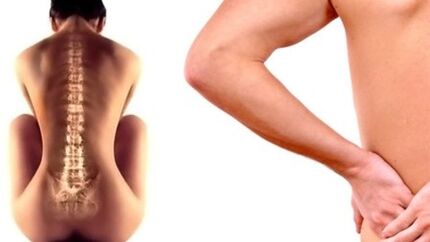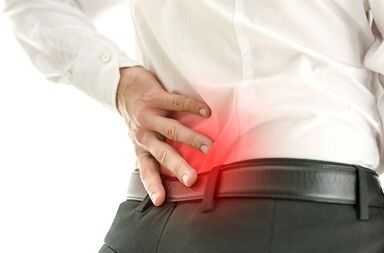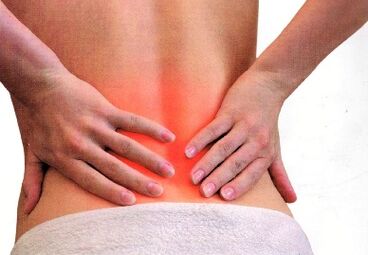Low back pain is one of the most common reasons that force patients to seek help from a neurologist or therapist. Lumbosacral pain can cause permanent disability, making exercise and self-care impossible. Acute low back pain also often affects men and women.
The incidence is higher in middle-aged and elderly people, and low back pain often occurs in teenagers and young people. This is due to rapid growth, weak muscles and injuries in the lower back. Therefore, lumbosacral pain is the most pressing problem that anyone can face.

Lower back pain caused by lumbar osteochondrosis
Lower back pain with osteochondrosis can be exacerbated by coughing and sneezing and any exercise, especially when the body is bent forward. Accompanied by back pain, lumbar osteochondrosis can manifest as the sensitivity of some areas of the skin or muscles of the lower half of the trunk and legs are violated, and the leg tendon reflexes are weakened or disappeared.
- Usually, with osteochondrosis, the lumbar spine is bent. According to the plane of curvature, scoliosis (curved to the right or left), lordosis (curved forward), and kyphosis (smooth lumbar spine or even backwards) can be distinguished. If you have osteochondrosis, the spinal cord is squeezed, urination or defecation is violated, and the sensitivity of the bladder or genitals is violated.
- However, the most common form of lumbar osteochondrosis is radicular pain-that is, it develops due to compression of the nerve roots extending from the spinal cord at one or the other level. Therefore, one of the well-known lumbar syndromes is low back pain. It occurs at a moment of physical stress or an awkward position of the body, sometimes for no obvious reason. Suddenly, within minutes or hours, severe shooting pain ("back pain"), usually burning and bursting ("like a wooden stake stuck in the lower back") occurs.
The patient is stiff in an uncomfortable position and cannot stand upright if a seizure occurs during weightlifting. Trying to get up, coughing, or bending your legs can be accompanied by a sharp increase in lower back and sacrum pain. If the patient is asked to stand on both feet, the entire waist area is obviously unable to move due to muscle tension.
Lumbosacral osteochondrosis examination
These tests are used as a way to make a preliminary diagnosis, and they are named after the doctor who advised them.
| Dejelin's symptoms | If you tighten your abdomen and listen to your lower back, the pain will become more intense. In this case, the patient is highly likely to have osteochondrosis. |
| Symptoms of Neri | If the head is tilted forward sharply before touching the chest, the lower back is painful, which also indicates a problem with the spine. |
| Lasseger symptoms | This can be felt after the following actions: lying on your back, you need to lift each leg in turn. If after that, the waist is twisted and the pain will be transmitted to the legs along the sciatic nerve, this is evidence of spinal disease. |
| Larry's symptoms | If a person has pain along the sciatic nerve, after he stands up forward from a lying position without bending his knees, we are talking about the manifestations of rickets. |
Herniated disc
A herniated disc is an equally rare cause, and its clinical manifestation is lumbosacral pain. The intervertebral disc (nucleus pulposus) will lose its elastic properties and elasticity with prolonged trauma exposure and aging.
With continuous exposure (overweight, trauma, progressive osteoporosis), the fibrous annulus of the intervertebral disc becomes thinner and forms defects in it. Through these weak points in the annulus, the nucleus pulposus of the intervertebral disc can move or even protrude.
Causes of low back pain
Back pain is a non-specific symptom that can be caused by many different reasons. From the degree of pain in the waist and back, whether it is constant or periodic, primary or secondary, there may be reasons for it:
Chronic pain:
- osteomyelitis;
- Ankylosing spondylitis;
- Deformable spondylosis;
- Growth diseases-scoliosis;
- Infectious diseases of the intervertebral discs and vertebrae (epidural abscess, spinal tuberculosis, brucellosis);
- Metabolic bone disease-osteomalacia, osteoporosis;
- Primary and metastatic tumors of the spinal cord, vertebrae, and retroperitoneal space;
- Non-infectious inflammatory diseases-rheumatoid arthritis, Wright's syndrome, ankylosing spondylitis;
- Kidney tumors;
- Abdominal atherosclerosis of the aorta and its branches.
Acute pain:
- Spondyloarthritis;
- Hip pathology;
- Spinal epiduralitis;
- Lumbar disc herniation;
- Spinal condyle;
- Acute intervertebral hernia;
- Intestinal obstruction, atypical course of acute appendicitis;
- Urolithiasis;
- Acute sprains, vertebral fractures;
- Low back pain, sciatica;
- Acute diseases of the spinal cord circulation-stroke;
- Acute pyelonephritis.
Radiating pain of some visceral diseases:
- Diseases of pelvic organs. In women-inflammatory processes of the uterine appendages, endometriosis, uterine cancer, ovarian cancer, venereal diseases (chlamydia, ureaplasmosis, gonorrhea, trichomoniasis, etc. ) in men-prostatitis, prostate cancer;
- Stomach, pancreas, duodenum, gallbladder diseases;
- Intestinal diseases-inflammation of diverticulum, ulcerative colitis, intestinal tumors;
- Kidney disease-renal colic, kidney stones;
- Aortic dissecting aneurysm.

Physiological reasons
if you:
- overweight;
- Additional risks for women;
- You are pregnant or have just given birth;
- Spend a lot of time driving a car or computer;
- Lead a sedentary (office worker) or standing (vendor, waiter, street sign, surgeon) lifestyle;
- Perform dynamic manual labor with sharp changes in body position (especially when your major is related to heavy physical activity);
- Overload yourself in the gym or health club. If you recently started training, please be extra careful;
- Like summer cottage work;
- Has reached the menopause, which is conducive to the development of osteoporosis.
Low back pain and pregnancy
Pregnancy exacerbates the manifestations of diseases existing in the mother's body. Due to changes in hormone levels and increased load, diseases are especially common in the second half of pregnancy. In addition to the pain that accompanies the threat of preterm birth, the causes of lumbago in pregnant women may be:
- Herniated disc;
- Radiculitis;
- pancreatitis;
- Pyelonephritis;
- Urolithiasis (kidney stones) disease.
Why does the lower back pain
In the case of low back pain below the waist, in addition to obvious spinal diseases (sciatica, low back pain, intervertebral disc herniation, ankylosing spondylitis, etc. ), possible causes include women's menstrual pain, female reproductive organ diseases, and inflammation of uterine appendages-oophoritis, fallopian tubesOvarian inflammation (attachment inflammation), as well as pelvic peritoneal disease, intestinal disease, appendix inflammation (cecal appendix), male-prostate disease, bladder disease.
Pain in the upper lower back
If the back is painful above the right lower back-so liver pain can radiate, and there are any pathological changes in the liver-hepatitis, liver failure, take toxic drugs. The pain in this case is most often located on the right side of the flank.
If you feel pain on the right or left side above the waist, the cause is likely to be acute kidney disease. Many chronic kidney diseases, such as polycystic kidney disease, renal malignant tumors, chronic pyelonephritis, etc. , are accompanied by mild symptoms due to the gradual stretching of the kidney capsule.
When should you see the doctor?
- If the back pain radiates to the lower back, and it is located slightly higher (in the chest area). The pain is accompanied by sweating, vomiting and nausea, and shortness of breath.
- The pain radiated to the peritoneum, chest, neck, and jaw.
- The patient is dizzy.
- The tachycardia begins.
- Spinal trauma, accompanied by uncontrolled defecation and urination.
- Legs become weak, buttocks, and genitals become numb.

diagnosis
In order to determine the disease causing low back pain, a comprehensive diagnostic test is necessary.
Laboratory method:
- General and biochemical analysis of urine and blood.
- Detect tumor markers in the blood during tumor formation.
Instrument research method:
- X-rays of the spine.
- Endoscopy of the intestines, stomach and uterus.
- Abdominal ultrasound examination.
- Magnetic resonance imaging.
How to treat low back pain?
How to treat the lower back properly? The method of back treatment depends entirely on the symptoms of the disease, the doctor’s diagnosis, and the stage of the disease. Generally, a comprehensive approach including multiple treatment methods is used.
painkiller. . .The ointment helps relieve inflammation, stretches, and has a warming effect if the waist catches a cold.
Distinguish the following groups of ointments:
- Combination drugs (used for sprains and injuries, have anti-inflammatory and analgesic effects, due to the healing effects of their ingredients);
- Anti-inflammatory and analgesics (they contain medicinal substances with a cooling effect that relieve irritation-menthol, lavender and painkillers);
- Cartilage protective agent (one of the active ingredients of this type of drug is a substance used in the pathological process of cartilage tissue, which helps to actively repair the surface of articular cartilage);
- Stimulant drugs (the effect is based on vasodilation and blood flow to the source of pain).
With the help of therapeutic exercises, patients will be able to reduce pain, increase muscle strength, and increase the distance between the vertebrae. They will help release compressed nerve roots, normalize blood flow in the affected area, and improve metabolic processes.
In order to recover from this type of gymnastics without disability, all the recommendations of the attending physician must be followed.
- Movement is slow and steady, without sharp turns;
- The room must be ventilated before training;
- Patients should wear clothes that do not restrict movement;
- The patient exercises when he inhales, and he needs to return to his original position when he exhales;
- The load gradually increased. First, the number of entries is around 10, and then increase;
- During gymnastics, you should monitor your health. If it starts to have severe pain, then you need to stop studying.
In addition, massage is very suitable for relieving lumbar pain. The positive therapeutic effects of massage include:
- Improve blood supply to diseased parts of the body;
- Knead muscles to make them and ligaments more flexible and elastic;
- Relieve acute pain;
- Remove toxins accumulated in muscles and subcutaneous tissues;
- A pleasant sensation due to stimulation of the nerve endings of the skin;
- Positive emotions.
It can be entrusted to a specialist in a clinic or performed at home, however, the benefits from it will be invaluable.
Which doctor should I see?
For unexplained back pain, the first step is to see a therapist. It will help determine the disease through the combination of symptoms.
If the cause is obvious: the pain is caused by an injury, and the pain occurs in the context of pregnancy, menstrual cycle, or chronic disease, then it makes sense to contact a smaller expert immediately.
Self-administration is only allowed if the cause of the pain is known.
















